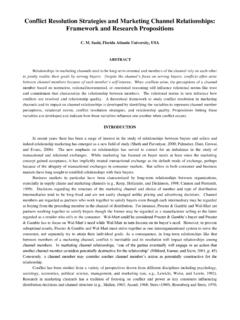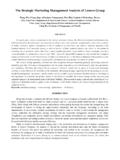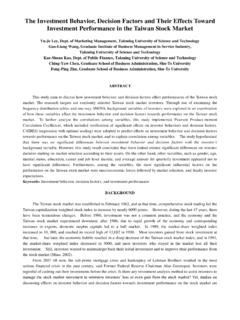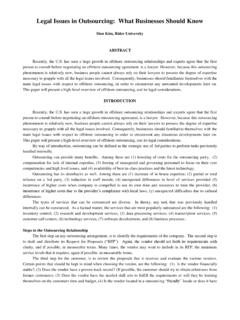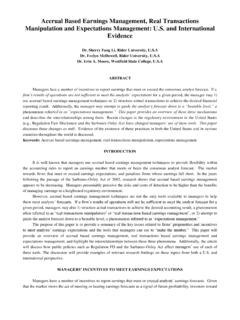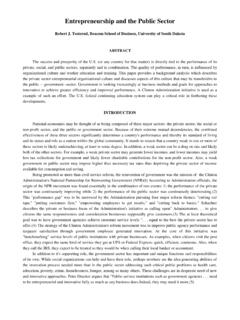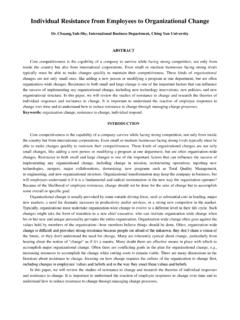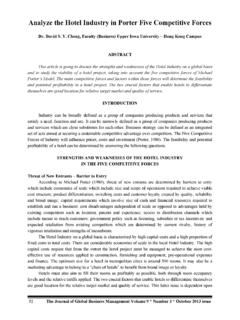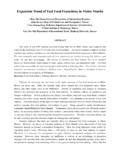Transcription of Analysis of Global Marketing Strategies in Distilled ...
1 Analysis of Global Marketing Strategies in Distilled Spirits Industry: Absolut Vodka Dr. Etienne Musonera, College of Business, Eastern New Mexico University, USA Dr. David Hemley, College of Business, Eastern New Mexico University, USA ABSTRACT The vodka industry is in a revitalized phase despite the assertions by most analysts that it is in the mature phase of its product life cycle. The focus of this study is to evaluate Global Marketing Strategies in Distilled spirits industry, and our Analysis will concentrate on four issues that seem to delineate the conventional vodka Marketing landscape.
2 They are Mature Industry, High Brand Loyalty, Too Many Competitors, and Limited Marketing Opportunities. Keywords: Vodka, Competitive Marketing Strategies , Spirit Industry INTRODUCTION Despite whom you might ask, the origins of Vodka (Slavic for little water ) come from either Poland or Russia. But the 500+ years of development have created one of the most competitive brand battles in the Distilled spirits industry. Vodka accounts for nearly one-quarter of all Distilled spirit sales, and continues to show annual growth despite the assertion by many marketers that the product itself is in the mature phase of its life cycle.
3 Vodka can be classified three ways: premium, super premium and ultra premium. These designations relate to the vodka s quality, which is attributed to the number of times the vodka is Distilled and what type of filtration process is employed. The vodka goes through this process several times to remove the impurities in the solution. The more times the process is employed the higher the status of premium placed upon the vodka. This in turn affects the consistency and taste of the vodka (which characteristically has no definitive taste).
4 As a result, the quality and taste of vodka become important selling points to the marketers. Normally these constructs, which are used in defining the value of what is being exchanged, are untenable due to their unambiguous nature. Yet the positioning placement of relevant competitors in the industry will indicate the import of these constructs, with the usage of two baseline variables consistent across the entire industry. There are many issues facing the vodka companies today.
5 The focus of this study will concentrate on four issues that seem to delineate the conventional vodka Marketing landscape. They are Mature Industry, High Brand Loyalty, Too Many Competitors, and Limited Marketing Opportunities. Mature Industry Most marketers tend to agree that the vodka industry can be characterized as being in the mature phase. In defining the product and market portfolio, the Boston Consulting Group Matrix defines the mature industries (or Cash Cow ) in the following manner: mature products that make lots of money, difficult to grow, difficult to find new consumers (Voyle, 2002; ).
6 In other words, the Vodka Industry can be considered a Cash Cow simply because it has a high market share in tandem with the rest of the Distilled spirits industry (25% of the Distilled spirits sold in the ) but growth potential is low and presently all competitors are at the harvest stage, meaning they try to steal away potential customers from others while maintaining their own core clientele (Estes, 2000). Also, this industry classification reflects the tendency that most competitors will generate lots of money.
7 According to a study released by AC Nielsen, the 2001 yearly sales for Vodka at Liquor Stores and Supermarkets were $592 million in the US, up from the previous year. Yet this was an indicative of an overall slowdown in the consumer purchase of Vodkas from 2000 figures, which were at $552 million or up from the previous year (Hein, 2001). The marketers express the need to increase their product portfolios through the introduction of products that will skew toward the lower end of the age demographic.
8 To this end, many Vodka manufacturers have created flavored Vodkas and Malternatives (malt-based alcoholic beverages with some vodka content). The danger of producing these so-called Alcopops is that the Marketing campaigns tend to attract underage drinkers. High Brand Loyalty Vodka experiences high brand loyalty owing to the fact that users in this segment rarely experiment with new products. The consumers may experiment with product line extensions of their favorite name brand, like the new flavored vodkas, but rarely venture out of the family line.
9 In fact, because of the considerable amount of competitors in this industry, consumers tend to actively seek out a product that has name recognition or a status attached to it. The argument here is that to an extent the consumer forms a bond with a specific vodka brand and this bond is hard to separate-Self-Concept. Also, young women (18-24 age range) have been recently categorized as spirits drinkers that would seek out new brands and new venues, more so that men in the same age demographic.
10 These women are considered highly impulsive with regards to drink experimentation as opposed to the pack mentality characteristically found in men (Mason, 2000). Too Many Competitors With several hundred different choices of flavored/non-flavored, domestic/imported, and super-/ultra-premium Vodkas out in the marketplace, the need to differentiate becomes vital to the survival of these brands. Some brands may differentiate in quality (Grey Goose, Ketel One), others use urban legends (Skyy doesn t cause hangovers) and Country of Origin Image (Stolichnaya Russia) to raise their profile in very competitive Vodka market.
